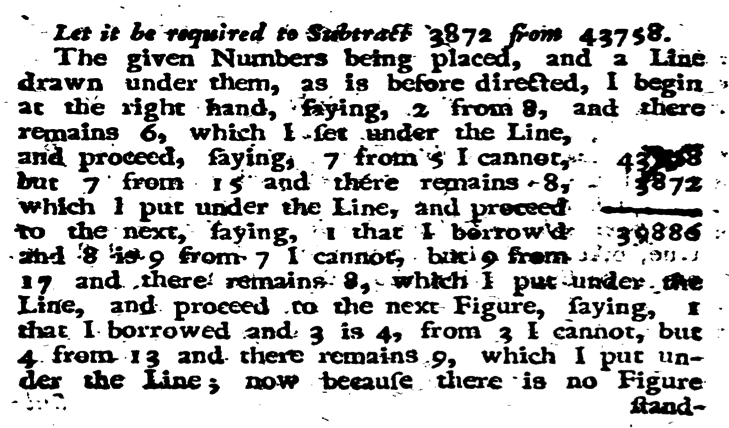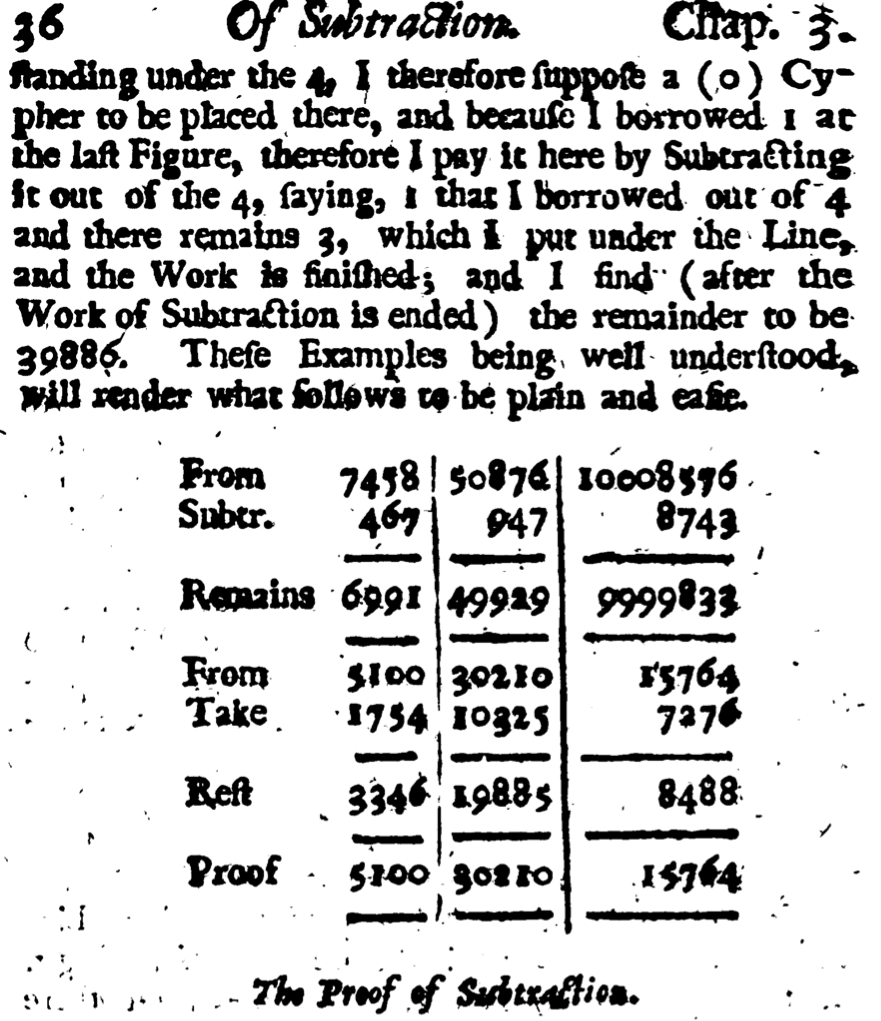- About MAA
- Membership
- MAA Publications
- Periodicals
- Blogs
- MAA Book Series
- MAA Press (an imprint of the AMS)
- MAA Notes
- MAA Reviews
- Mathematical Communication
- Information for Libraries
- Author Resources
- Advertise with MAA
- Meetings
- Competitions
- Programs
- Communities
- MAA Sections
- SIGMAA
- MAA Connect
- Students
- MAA Awards
- Awards Booklets
- Writing Awards
- Teaching Awards
- Service Awards
- Research Awards
- Lecture Awards
- Putnam Competition Individual and Team Winners
- D. E. Shaw Group AMC 8 Awards & Certificates
- Maryam Mirzakhani AMC 10 A Awards & Certificates
- Two Sigma AMC 10 B Awards & Certificates
- Jane Street AMC 12 A Awards & Certificates
- Akamai AMC 12 B Awards & Certificates
- High School Teachers
- News
You are here
An Investigation of Subtraction Algorithms from the 18th and 19th Centuries - The Equal Additions Algorithm
Example of the Equal Additions Algorithm
Consider the subtraction problem, \(940-586,\) or
| \(9\) | \(4\) | \(0\) | |
| \(-\) | \(5\) | \(8\) | \(6\) |
To begin subtraction with the Equal Additions Algorithm, ten would be added to the minuend in the ones position and ten would be added to the subtrahend by placing a one in the tens position. Using modern notation, we may add markings as shown in the video. In the ones position, instead of \(0-6,\) we now have \(10-6,\) giving us \(4,\) since we added \(10\) to the ones position. In the tens position, instead of \(4-8,\) we now have \(4-9\) since we added \(1\) in this position. Because we have \(4-9,\) we would need to apply the Equal Additions Algorithm again.
See the Equal Additions Algorithm in action using the example \(940-586\):
Historical Discussion
The so-called “equal additions” algorithm was the most widely used algorithm from 1700 to 1900 (Ellerton & Clements, 2012). The algorithm obtained its name because the method essentially adds an equal number, ten, to both the minuend and the subtrahend. Thus, this algorithm is primarily based upon the identity \(a-b=(a+k)-(b+k).\) David Eugene Smith (1909) called the equal additions method “the borrowing and repaying plan.” He stated that this algorithm has roots dating back to Pietro Borghi (also known as Piero Borgi), who, in 1484, wrote the first great business arithmetic ever printed. The equal additions algorithm was also used by arithmeticians in India and in Constantinople before printing was invented (Smith, 1909). Jackson (1906, cited in Johnson, 1938) stated that the equal additions algorithm could be found in many sixteenth century texts.
Joseph Ray (1856) provided a rule for “subtracting simple numbers” that is commonly found in nearly all texts supporting the equal additions algorithm (See Figure 5).

Figure 5. Instructions for the equal additions algorithm on page 23 of Ray’s higher arithmetic: The principles of arithmetic, by Joseph Ray, published in Cincinnati, Ohio, in 1856. (This image has been reproduced from a Google Book with free access.)
Part three of the rule stated above is a typical statement. From 1700 to 1900, it was quite common to encounter the equal additions algorithm, as well as any other algorithm, with no explanation of why the algorithm worked (Ayres, 1711; Botham, 1835; Brookes, 1776; Cocker, 1677; Daboll, 1829; Dilworth, 1802; Greenwood, 1729; Ray, 1856/1877; Record, 1658; Walsh, 1828; Weston, 1729; Wingate, 1865).


Figure 6. This example of the equal additions algorithm appears on pages 35 and 36 of Arithmetick: A treatise defined for the use and benefit of trades-men (11th edition), by John Ayres, published in London, England, in 1711. Ayres published the first edition of this text in 1693 as Arithmetick: A treatise fitted for the use and benefit of such trades-men as are ignorant in that art. (These images have been reproduced from a Google Book with free access.)
Nicole M. Wessman-Enzinger (Illinois State University), "An Investigation of Subtraction Algorithms from the 18th and 19th Centuries - The Equal Additions Algorithm," Convergence (January 2014)




